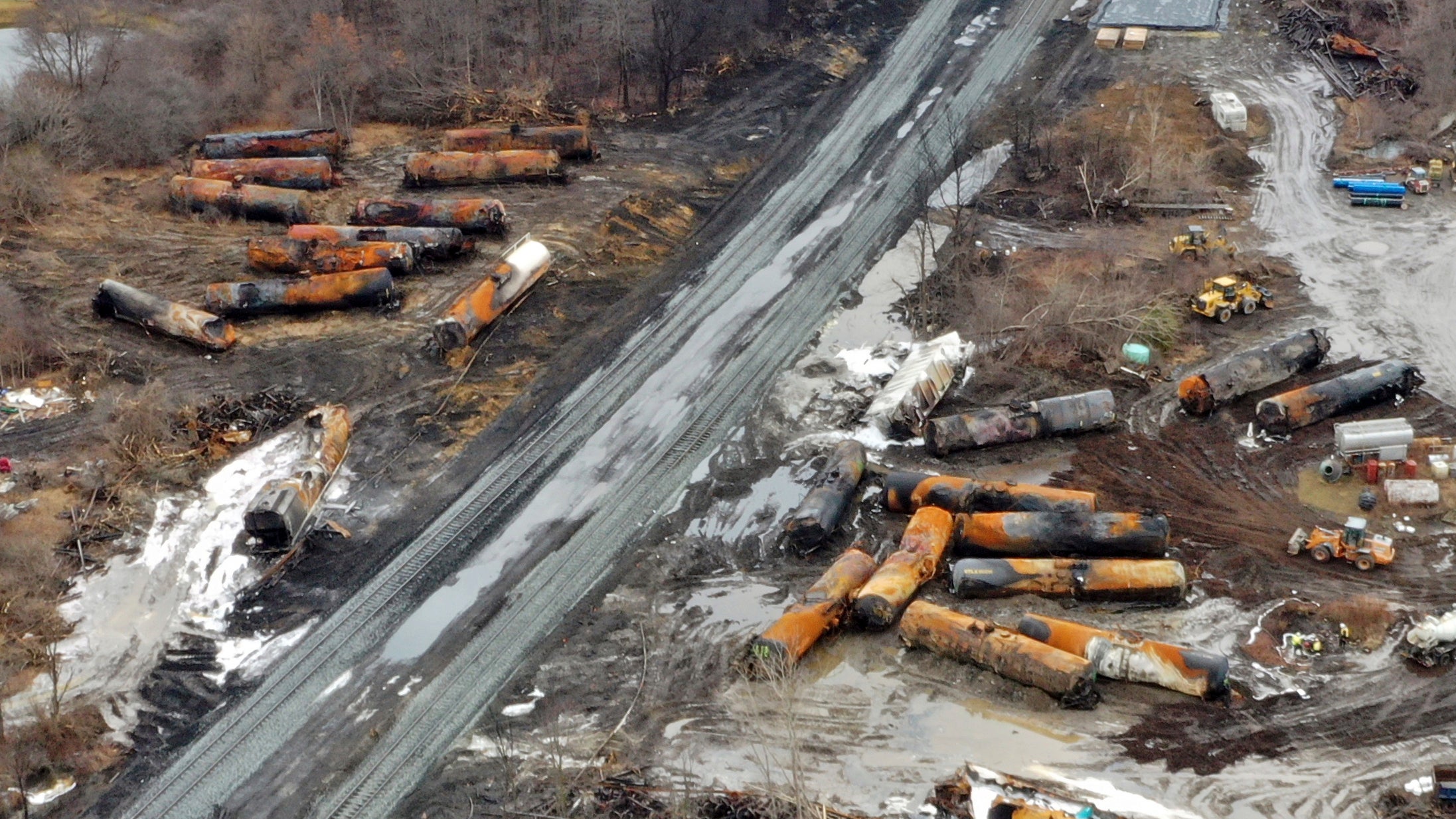Ohio Train Disaster: Persistent Toxic Chemicals In Nearby Structures

Table of Contents
Detection and Measurement of Persistent Toxic Chemicals
Determining the extent of the contamination requires meticulous testing and measurement of toxic chemicals in various mediums. Soil sampling is crucial for identifying the spread of contaminants in the ground, potentially affecting residential properties and groundwater sources. Air quality testing is essential to assess airborne pollutants and their potential for inhalation exposure. Water analysis helps determine the level of contamination in local water sources, crucial for drinking water safety and overall environmental health.
Credible sources, including government reports and independent scientific studies, are vital for accurately assessing the levels of contamination. Preliminary findings reveal concerning levels of toxic substances:
- Elevated vinyl chloride levels: Reports indicate detectable levels of vinyl chloride have been found in several residential homes, exceeding safe limits according to EPA standards. The specific methodology employed involved using EPA Method TO-15 for air sampling and EPA Method 8260B for soil and water samples.
- Butyl acrylate contamination in water sources: Analysis of nearby water sources shows the presence of butyl acrylate, raising serious concerns about potential long-term health risks for residents relying on these sources. Further investigations are underway to trace the extent of this contamination.
- Long-term health risks: Prolonged exposure to vinyl chloride and butyl acrylate is associated with various health problems, including liver damage, cancer, and respiratory issues. The long-term health impacts on the exposed population remain a significant concern.
- Advanced Testing Methodologies: Beyond standard methods, advanced techniques like gas chromatography-mass spectrometry (GC-MS) are being employed to identify and quantify a broader range of persistent pollutants.
Impact on Residential Structures
The pervasive nature of the contamination poses significant challenges for residents. Many homes have experienced soil contamination, requiring extensive and costly remediation. Air infiltration of toxic chemicals is another major concern, impacting indoor air quality and potentially causing respiratory problems. Water contamination poses risks to drinking water sources and requires thorough investigation and remediation.
Homeowners face substantial financial burdens:
- Contaminated soil: The cost of excavating and replacing contaminated soil is considerable, often exceeding the financial capacity of many residents.
- Remediation expenses: The process of cleaning and remediating affected properties can take months or even years, requiring ongoing monitoring and treatment.
- Long-term health concerns: The anxiety and fear surrounding potential long-term health consequences add to the stress and financial strain on affected families.
- Insurance coverage challenges: Many homeowners find that their insurance policies do not adequately cover the costs associated with cleaning up toxic chemical contamination, leading to financial hardship.
Impact on Businesses and the Local Economy
The Ohio train disaster's impact stretches far beyond residential areas, significantly affecting local businesses. Businesses near the derailment site have experienced closures, decreased property values, and substantial revenue losses. The long-term economic repercussions could be devastating for the entire community.
The following bullet points highlight the extent of this economic damage:
- Business closures: Several small businesses have been forced to close due to the contamination, resulting in job losses and further economic hardship.
- Declining property values: The presence of toxic chemicals has significantly lowered property values, making it difficult for businesses to secure loans or sell their properties.
- Reduced consumer confidence: The negative publicity surrounding the disaster has impacted consumer confidence, leading to decreased spending and further harming the local economy.
- Government aid and support: While some government aid has been announced, the extent of support remains insufficient to address the widespread economic damage.
Long-Term Health Effects and Concerns
The potential long-term health consequences for residents exposed to the toxic chemicals released in the Ohio train disaster are a paramount concern. Exposure to vinyl chloride and butyl acrylate has been linked to various serious health issues, and ongoing monitoring of health conditions in the affected area is crucial.
These long-term risks include:
- Cancer risks: Both vinyl chloride and butyl acrylate are classified as carcinogens, increasing the risk of various cancers in exposed individuals.
- Respiratory problems: Exposure to these chemicals can lead to respiratory illnesses, including asthma, bronchitis, and other lung conditions.
- Liver damage: Vinyl chloride is known to cause liver damage, potentially leading to cirrhosis and liver failure.
- Ongoing health monitoring: Public health officials are implementing and supporting long-term health monitoring programs to track the health status of residents and identify any potential long-term effects.
Government Response and Regulatory Actions
The government's response to the Ohio train disaster has been met with criticism, with concerns raised about the speed and effectiveness of the cleanup efforts and the support provided to affected communities. While cleanup operations are ongoing, questions remain about the long-term effectiveness of the remediation process and the potential for future contamination events.
The following key points highlight this complex issue:
- Cleanup efforts: While cleanup efforts are underway, concerns persist about the thoroughness of the process and the potential for residual contamination.
- Regulatory actions: The regulatory response has been criticized for not being proactive enough and for potentially failing to address the long-term consequences of the disaster.
- Future regulatory implications: The disaster has highlighted the need for stricter regulations surrounding the transportation and handling of hazardous materials.
- Legal action: Several lawsuits have been filed against the railroad company and other involved parties, seeking compensation for damages and injuries.
Conclusion
The Ohio train disaster has unleashed a wave of persistent toxic chemical contamination, profoundly impacting the affected community. The lingering presence of harmful chemicals in homes, businesses, and the environment poses serious risks to public health and the local economy. The government's response, while ongoing, has faced considerable scrutiny, underscoring the need for a more comprehensive and effective approach.
We urge readers to stay informed about the ongoing Ohio train disaster and its lasting effects. Support the affected communities by donating to relevant organizations providing aid and assistance. Contact your representatives to advocate for stronger regulations and increased support for those impacted by this catastrophic event. The persistent contamination from the Ohio train disaster demands continued attention and action to ensure the long-term well-being of the affected population and the environment. The effects of the Ohio train derailment require sustained vigilance and concerted effort to mitigate the lasting damage.

Featured Posts
-
 Cannes Film Festival The Thriving Black Market For Tickets
May 23, 2025
Cannes Film Festival The Thriving Black Market For Tickets
May 23, 2025 -
 Analyzing Dan Lawrences Chances Of An England Test Opening Role
May 23, 2025
Analyzing Dan Lawrences Chances Of An England Test Opening Role
May 23, 2025 -
 The Untold Story Cobra Kais Early Development And Mock Trailer Presentation
May 23, 2025
The Untold Story Cobra Kais Early Development And Mock Trailer Presentation
May 23, 2025 -
 Cricket Bat Mastery A Timeless Tradition
May 23, 2025
Cricket Bat Mastery A Timeless Tradition
May 23, 2025 -
 A Geographic Overview Of The Countrys Emerging Business Markets
May 23, 2025
A Geographic Overview Of The Countrys Emerging Business Markets
May 23, 2025
